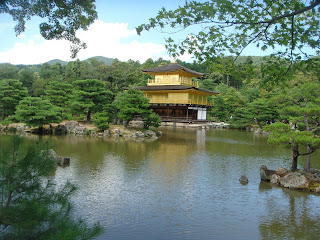I always get
the impression that the religious function of the Kinkaku-ji 金閣寺 is far less important than its touristic function, even
compared to other major sacred areas in Kyōto like Kiyomizu-dera 清水寺 and Fushimi Inari-taisha 伏見稲荷来社. However, this does not mean
that there are no traces at all of authentic folk religion on the temple grounds.
You
can see the Buddha statues shown above along the road behind the Kinkaku-ji.
People throw coins at the hole in the ground and the singing bowl. Just for fun?
Or perhaps for good luck and protection?
A small temple dedicated
to Fudō-myōō 不動明王 on the Kinkaku-ji grounds.
According to an inscription the Fudō-myōō statue which is the temple’s main idol,
is made by the legendary Kōbō-daishi 弘法大師 (Kūkai
空海).
A Shintō style shrine to the originally South-Asian
creature(s?) called Dakini-ten 吒枳尼天
(Skt.:
Ḍākinī). In Japan this deity has become closely associated with the native
deity Inari 稲荷
since
the middle ages .
The remains of the Daimonji-yaki 大文字焼きas seen
from just outside of the Kinkaku-ji grounds (Around O-bon お盆, fires shaped like the character 大
(meaning “big”) can be seen in Kyōto).
Sources:
* Inscriptions on the premises of the Kinkaku-ji (August, 2012).









